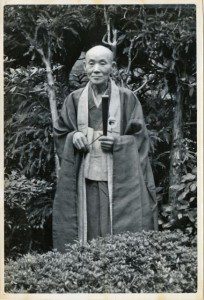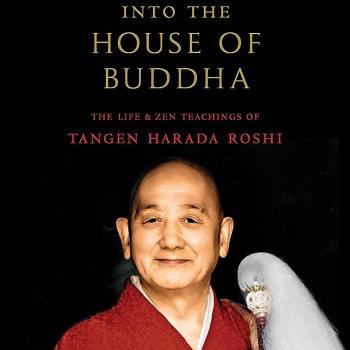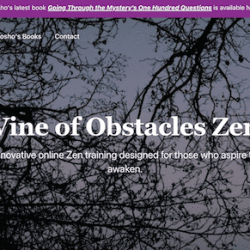 This morning after zazen, we offered incense and the recitation of the Heart Sutra to Daicho Hayashi-roshi (or Kaigai Daicho Zenji) the teacher of Katagiri-roshi and so my dharma grandfather. It is his memorial day today. Hayashi-roshi died not knowing the impact that his life and teaching would have through Katagiri-roshi and those many that he impacted indirectly.
This morning after zazen, we offered incense and the recitation of the Heart Sutra to Daicho Hayashi-roshi (or Kaigai Daicho Zenji) the teacher of Katagiri-roshi and so my dharma grandfather. It is his memorial day today. Hayashi-roshi died not knowing the impact that his life and teaching would have through Katagiri-roshi and those many that he impacted indirectly.
Here’s a post from 2008 where I give some of the detail of his life.
Hayashi Roshi’s dharma name was Kaigai Daicho, meaning “Beyond the Ocean, Great Tides.” His name is strangely prescient given that his disciple, Katagiri-roshi, would come to America. I am interested in his story in part because it shows the huge changes that we’ve gone through in just a few generations. What follows is information about him that I’ve gleaned from conversations with Tomoe Katagiri and others.
I don’t have Hayashi-roshi’s exact dates yet but he lived from late in the nineteenth century until the mid 1970s. His father was very wealthy and high in the government and served both as a prefecture governor and as the first education minister of Japan during the the Meiji reformation.
Hayashi-roshi’s father had a “second wife,” a geisha, for whom he dumped his first wife. For some time while Hayashi-roshi was young he had thought that the second wife was his mother. Then one day when he was six years old he did something wrong and the second wife tied him to a persimmon tree and left him there. Apparently, this wasn’t unusual in Japan in those days. His nanny eventually found him and sobbing said, “She wouldn’t have done this if she was your real mother.”
The next morning Hayashi-roshi said he was going to go to school but instead went to a Zen temple and asked to become a monk. The master (my dharma great grandfather, Yozan Genki) said he had to get permission from Hayashi-roshi’s father because he was so young. Hayashi-roshi’s father came to the temple and said, “This boy lied and went to the temple when he said he was going to school. Therefore, he is not my son and not my business.” He never came to even visit after that and Hayashi-roshi never saw him again. “Hayashi” was Genki-roshi’s family name, not his biological father’s.
Hayashi-roshi went to Eiheiji for many years. While at Eiheiji he became the jisha (ceremonial attendant) for Kumazawa-roshi when the latter had some important position there but before he was abbot. Kumazawa-roshi later became abbot Eiheiji and was abbot for a long time, including when Katagiri-roshi was a monk there, explaining how Katagiri got to be the anja (daily-life attendant) of the monk in charge of training, Hashimoto-roshi.
Hayashi-roshi’s master, Genki-roshi, had a big temple in Nara and was raising money to rebuild some part of it when the old teacher lost most of the money gambling. This made the relationship between him and the community rather cold. Hayashi-roshi was offered the opportunity to become the abbot of the big Nara temple but hesitated because of the cold relationships with the community.
About that time he was traveling on a train and his real mother and he recognized each other and were reunited. Hayashi-roshi had searched for her for many years. She was eking out a living taking care of a small shrine for a famous samuria near Tsuruga on the Japan Sea. Hayashi-roshi somehow was offered the chance to rebuild a small temple at that site. He felt very torn between being the abbot of the big temple in Nara or taking this very small temple in Tsuruga. Eventually, he decided to rebuild the shrine and it became Taizoin, the temple where Katagiri-roshi lived and trained with him. Hayashi-roshi took care of his mother there until she died and also Chozan Genki when he was old.
Before and after he found his mother and settled at Taizoin, Hayashi-roshi traveled widely as a lecturer, not only on Kyushu but going way up into Komosomul’ska-amure (big island north of Hokkaido that before the war was part Soviet Union and part Japan). Hayashi-roshi loved to travel, just like Katagiri-roshi.
Hayashi-roshi liked that Katagiri-roshi came to America as he hadn’t gotten the chance. He had stopped traveling when he got older. Hayashi-roshi rebuilt the hondo (ceremonial hall) at Taizoin but not the keisando (living area) so that the ceiling was almost nonexistent when Tomoe stayed there – snow fell in all over and you could lay on your futon on look at the stars. Eventually it was rebuilt.
Hayashi-roshi lived very straightly, always wearing robes, etc. He thought that he was very unlucky when it came to disciples, except for Katagiri-roshi. Hayashi-roshi had ordained about twelve priests but they had run away, gone crazy, were in jail, etc.
Hayashi-roshi ate all his meals with oryoki and kept the practice schedule even when no one was there. He didn’t go into the village and hang out with people or talk much at all. He didn’t drink and was allergic to alcohol but that wasn’t the reason that he didn’t drink. He was allergic to many things and was often sick. Mostly he quietly followed the schedule and then sat in the room with the hibachi (even in summer) and loved to smoke a pipe with a long bamboo stem and metal bowl. Sometimes he listened to the radio but because Taizoin is surrounded by mountains in the direction of cities, the reception was bad.
Tomoe-san brought a small TV with her when she stayed there for four months in the early 1960′s and they put the antenna on the top of the hondo roof. Hayashi-roshi loved to watch sumo even though the reception was awful. I saw a picture of Hayashi-roshi from about this time and was impressed with his happy, relaxed demeanor. He had a big smile in the picture (traditionally Japanese people don’t smile in photographs).
Hayashi-roshi had broad and deep learning although Tomoe-san said she never saw him read a sutra – that was already inside him, she said. Hayashi-roshi had studied medicine for a long time and like to read books about healing. When he was growing up and young, he had been the helper of a doctor who came to his temple once a week and would treat people. His interest in healing came from there. He also helped people at Taizoin. He also was very interested in I Ching and kept the sticks for throwing the I Ching in a special box that was kept in the altar. Village people would come to him for advice about all sorts of things. In those days the temple was the center of the village life and people came to the temple for everything.
The woman that Katagiri-roshi had first gone to and requested ordination was a Pure Land priest. She knew of Hayashi-roshi and took Katagiri-roshi to him and introduced them. Katagiri-roshi was accepted and stayed three months practicing as a novice before ordination. Then shortly after he was sent to Eiheiji. After Eiheiji he wanted to go to Hashimoto-roshi’s temple for more training. Hayashi-roshi told him, “You can go but a teacher will not change you. You must change you.” Katagiri-roshi was deeply impacted by that and so stayed with Hayashi-roshi.
Katagiri-roshi told me that Hayashi-roshi called for him before he died. I believe Katagiri-roshi felt quite badly that he hadn’t been present for his master’s death.











